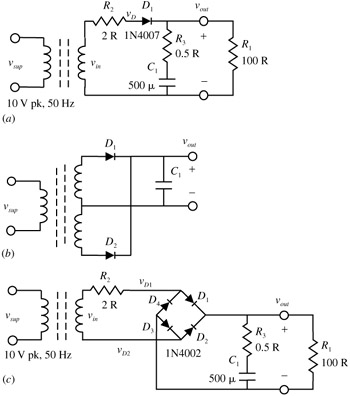I was calculating the heat watts needed to burn 6v 50ma, I figured I used 2 series 70 ohm 1/4 watt resistors each would divide the voltage drop into 2, 3v each resistor. So 3vX0.05A = .15 watts. For both resistors that would be .3 watts so I said a half watt resistor as this is standard and its good to give yourself a 3/2 overhead ratio with the .5 watt series divider,
Anyway,
We need to rectify the AC power transformers. Note I have not removed the original 220v AC connection so all I am playing with as it seems 15vdc at one amp. For each of these.
This tranformer is a multi-cenret-tap 15va transformer. I am going to use the neutral phase push for a positve DC rail and the active phase push for a positive DC rail and the center tap for ground.

The first two are half wave rectifiers, the first is with no center tap, one and the other, like mine with a centre tap. The third is a full wave recifier. It uses a trick where you can gain rail output by rectifying both push and pull phases of both neutral and active of the AC output of the transformer..
half wave rectifier
I used some IN5404 recifier diodes to convert the AC into DC wave form. Doing like this onto the transformer means I wont need to install diodes to any device I choose to us on it.
There are some different ways to mac the AC into DC. This half wave rectifier is very basic and keeps the volts per one amp VCA close to the rail voltage.
The Black wire will be ground, and the the end points of the diodes will be the output.
Edit sorry for the wrong process.